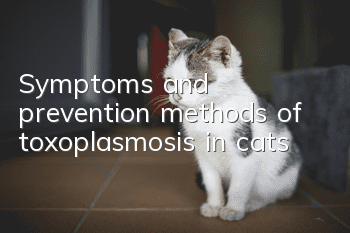Symptoms and prevention methods of toxoplasmosis in cats

Feline toxoplasmosis is a parasitic disease caused by the Toxoplasma protozoa. Humans and many other animals can be infected and endanger human health.
1. Pathogens
The pathogen is Toxoplasma gondii, a protozoan and an intracellular parasite. The trophozoite stage in the life cycle of the insect is arcuate in shape, hence its name. It is also called "Toxoplasma". Toxoplasma has two hosts, namely the intermediate host and the terminal host. Its life cycle includes 5 types of stages: trophozoite, cyst, schizont, gametophyte and oocyst. Trophozoites and cysts mainly appear in the bodies of intermediate hosts (mammals other than cats, birds, and some cold-blooded animals). Among them, trophozoites are more common in body fluids and tissue fluids in acute cases, and are mostly polymorphic, such as arcuate, Crescent shape, banana shape, etc. Cystic type is more common in the brain, retina, muscles, internal organs and other tissues and organs of chronic cases or cases without clinical symptoms. It is mostly round in shape with a thick outer layer of capsule, which is the relative quiescent stage of Toxoplasma gondii. Schizonts, gametophytes, and oocysts occur only in the terminal host. When a cat ingests meat containing trophozoites, cysts or mature oocysts, the parasites can enter the epithelial cells of the intestinal mucosa and reproduce asexually to produce merozoites. Some merozoites further develop into gametocytes, male and female gametocytes. Combined with sexual reproduction or into oocysts, the latter are excreted with feces and develop into infectious oocysts in a suitable environment in 2 to 4 days.
The worms swallowed by cats can also pass through the intestinal epithelium and enter the lymph and blood. They can reach various organs and tissues throughout the body, invade cells, and reproduce asexually by budding or bisection, producing a large number of worms. When the pathogenicity of the parasite is strong, it can cause acute illness in cats. Another situation is that the cat's body develops immunity or certain factors during the infection process, which slows down the reproduction speed of the parasites. Some of the parasites are eliminated by the body, and the other part forms cysts in the host's brain, skeletal muscles, etc. Cystic worms can survive for several years. Animals other than felines and humans are intermediate hosts for Toxoplasma gondii. It is usually due to the trophozoite or cyst of Toxoplasma gondii, which infects the intermediate host through a certain way. The worms enter tissue cells through blood and lymph and reproduce asexually. Due to the different resistance of the host, it may cause acute illness or hinder its reproductive capacity. The host may only show mild clinical symptoms or only have an asymptomatic latent infection state. The resistance of Toxoplasma varies greatly due to the different stages of the life history of the parasite. Among them, the resistance of trophozoites is the worst and can be killed by general disinfectants, such as 1% Lysol solution for 1 minute. Kill. The cyst-type parasites have strong resistance and can maintain infectivity for one and a half years at room temperature. They have strong tolerance to general acid and alkali disinfectants, but they are not resistant to high temperatures and can be killed in one minute at 80°C. , immediate death at 100°C.
2. Biographybroadcast channel
The route of transmission is relatively complex, and it can be transmitted intrauterine (that is, the fetus is infected through the placenta) or infected from the outside. Humans mainly infect the fetus through the placenta, but infection may also occur through blood transfusion. Toxoplasma patients have no risk of direct transmission to surrounding people. The same is true for many other animals. They themselves can be infected, but there is no direct risk of infection to surrounding animals unless their meat is eaten. Domestic cats are different from other cats because Toxoplasma can only form a new parasitic form of Toxoplasma, the oocyst, in cats. A cat can excrete 10 million oocysts in a day, which can last for more than 2 weeks. The immunity of sick cats is not complete, so they can be infected again and ovulate cysts repeatedly. Therefore, cats are the main source of invasion of this disease. The oocysts are excreted into the external environment with feces. Under suitable temperature and humidity conditions, they become infectious after 2 to 4 days. People and other animals can be infected by contact with soil containing the oocysts. Infect. The disease is mainly transmitted through the digestive tract, and artificial infection can cause disease through the mouth, throat, subcutaneous and abdominal cavity. According to reports, there is no significant difference in the incidence of cat breeds and genders, and the season has no significant impact on the occurrence of this disease. However, there are certain differences in the course of the disease at different ages. Kittens usually have an acute process, while adult or elderly cats have a chronic process.
3. Symptoms
The terminal hosts and intermediate hosts infected by Toxoplasma gondii generally have no obvious symptoms, and most of them become carriers through latent or subclinical forms. Only a few develop clinical symptoms. Cats infected with Toxoplasma gondii usually have a silent process. In young cats or when the body is in a state of stress, acute attacks may occur. Symptoms include elevated body temperature, diarrhea, dyspnea and pneumonia, and some may have neurological symptoms. Most adult cats are carriers of worms. Postmortem autopsy shows inflammatory and necrotic changes in the lungs, liver, spleen, lymph nodes, myocardium, and brain. Under the microscope, necrosis is seen, surrounded by polymorphous trophozoites, and some have resting cysts in the heart, brain, skeletal muscles, etc. The susceptibility of humans and other animals usually does not differ by age or gender, but it tends to increase with increasing exposure opportunities. It is reported that 45 species of mammals, 70 species of birds, 5 species of cold-blooded animals and some arthropods can be damaged as intermediate hosts of Toxoplasma gondii and also become the source of the disease.
4. Diagnosis
Diagnosis is generally made based on comprehensive analysis and judgment based on clinical symptoms, pathological changes, epidemiology and laboratory examinations. Among them, laboratory examination is the main basis. The indirect blood agglutination test is usually used, which is simple, fast, sensitive and specific. In addition, stained smears of blood, secretions, etc. can also be used for microscopic examination to observe whether there is Toxoplasma gondii. Methods such as animal vaccination and immunobiological diagnosis can also be used.
5. Treatment
There is currently no specific drug, but sulfa drugs have certain effects on acute attacks. Sulfadiazine is 75 mg per kilogram of body weight, combined with an antibacterial synergist at 15 mg per kilogram of body weight, taken orally twice a day for 5 days.
6. Prevention
Based on the life history of Toxoplasma gondii and the epidemiological characteristics of this disease, the following points should be done to prevent this disease:
1. Improve environmental sanitation, clean up cat feces in time, or bury it deeply or ferment it.
2. Pay attention to food hygiene. Cat food should be cooked and sterilized before feeding. Especially when the meat of suspected sick animals is used as feed, you should be more cautious to avoid infection.
3. Isolate suspected sick cats and treat them promptly.
Pay attention to living and dietary hygiene, isolate and treat in time once detected, and nip toxoplasmosis in the cradle.
- Can having a cat help relieve depression?
- How to care for newborn cats
- What's wrong with the cat not eating?
- Why do cats’ nails crack when they are cut?
- Can cats with oral herpes eat?
- Can Ragdoll cats eat rice?
- How to clear blocked nasolacrimal ducts in cats
- Cats need to be hungry for several days before they are willing to eat cat food
- Cat's toes have black scabs on them
- How often does a Chinchilla female cat go into heat? A Chinchilla female cat goes into heat!



